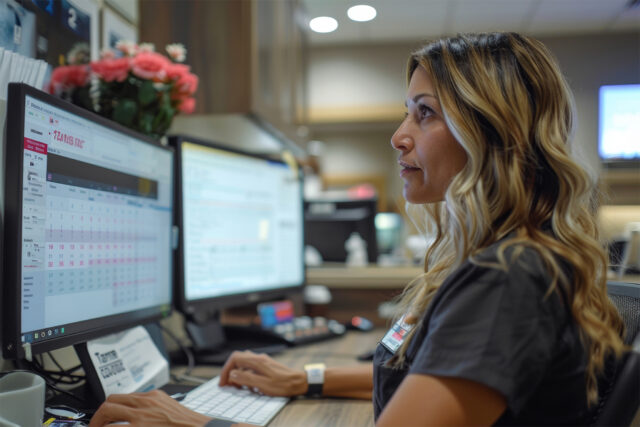Vinitha Ramnathan, Vice President of Product at Solutionreach, presented the webinar “3 Keys to Increasing Appointments in 2021” on July 20. Watch the webinar in its entirety here.
Today’s Appointment Workflow Challenges
It’s no secret that today’s healthcare providers face a series of ongoing hurdles when it comes to appointment operations that were exacerbated by the COVID pandemic in 2020–2021. Though providers are recovering, they’re still feeling the impact of these disruptions:
- Revenue shortfalls: Some physician specialties saw as much as 50 percent drop in revenue due to the pandemic.
- Fear of virus keeps patients away: 87 percent of patients were afraid to go to the doctor during the pandemic. This includes vaccine appointments.
- Patient satisfaction slipped: Patients’ satisfaction with their providers communication fell seven percent during COVID. That’s because the demands and expectation of patients has changed.
- No-shows continue to be costly: No-shows can range between 10 and 30 percent depending on the specialty. This includes COVID vaccine appointments, which had an eight percent no-show rate for people receiving a second dose. Lost revenue from no-shows annually per provider can be as much as $150,000 to $300,000.
Redefining the Appointment Workflow
The appointment workflow is also suffering from inefficient practices, disruptions like no-shows, and providers’ inability to connect effectively with patients for scheduling and appointment activities. A person can have a great visit but a less than stellar appointment experience. We often focus on the visit but there’s so much taking place before and after the visit to make sure the patient not only shows up prepared and on time but that they have a good end-to-end experience. A more refined and streamlined appointment workflow allows a provider to more effectively connect with a patient at every step in their healthcare journey. This includes everything from scheduling, to pre-visit instructions, to post-care communication and outreach. The four steps of a perfect appointment workflow include: schedule, prepare, same-day, visit, and follow-up.
“If you look at it a person’s care journey is a loop, it’s a constant,” Ramnathan said. “How do you ensure that the patient journey is something that you can consistently monitor and control?”
Tips to Increase Your Appointments
- It’s time to hang up the phone: Today’s patients don’t want to be bothered by phone calls due largely to consumer communication trends. Fourteen percent of patients say live phone calls are less desirable since COVID. Most people don’t answer calls from numbers they don’t know and nearly a quarter of people don’t check their voicemail. Manually contacting patients by phone calls just isn’t realistic anymore.
- Text-first is a winning approach: Eighty-five percent of people own a smartphone and 97 percent of them use it to text message. Most texts are read within minutes and texts are 209 percent more likely to be responded to because it’s easy to respond to a text. And texting isn’t limited only to younger generations. Seniors are increasingly embracing texting as a favored way to communicate. Recent data indicates that 79 percent of patients want to receive texts from their providers and 73 percent want to be able to send texts to providers.
Both automated texting and real-time two-way texting capabilities can significantly increase the effectiveness and efficiency of patient-provider engagement.
“What’s neat is that the technology these days, the platforms these days allow you to configure and to map it to what’s needed for your environment, your patients, and your setup,” Ramnathan said.
Texting and Social Determinants of Health (SDOH)
A lot of high-risk patients on Medicaid and Medicare need more than just a single text message from their provider. They need extra support and help accessing services such as transportation or scheduling a telehealth visit. They’re dealing with challenges of isolation and access. These are likely scenarios that providers have seen increasingly during the pandemic. As a trusted provider, you can reach out to these patients following surgery or urgent/emergency care through a text-first approach to SDOH outreach.
- It’s all about automation: Automation is about taking the first two steps of hanging up the phone and a text-first approach and making it more efficient. Across the patient journey, the desire for automated communication in high and continues to increase. Eighty-four percent of patients want more automated communication with their providers.
Automated recall: Serves two purposes—it keeps patients on track with preventive care and it improves health and outcomes for patients with chronic care conditions. Forty-eight percent of patients don’t schedule preventive recall appointments.
Automated reminders and instructions: If patients know what to expect and are better prepared for that visit, they are so much more efficient during the visit. Step one is knowing each patient’s communication preferences. Step two is sending text reminders (for telehealth or in-person visits) at a proven cadence. Data has shown that text reminders sent at three weeks, three days, and three hours increased appointment confirmations by 156 percent. The third step is to send advance reminders like pre-visit instructions for patients to complete paperwork, bring medication, fast before a visit, “park and text” instructions, or maps and wayfinding to ensure they show up prepared and on time.
Digital Intake: Ninety-three percent of patients expect healthcare organizations to use digital tools and 51 percent prefer a doctor that lets them complete forms online.
Chronic Care Condition Outreach
Both automated and real-time text messages can be powerful tools to help patients with chronic care conditions get the care they need when they need it. For example, with stroke outreach, a provider can text post-discharge follow-up messages, send a two-way text for a follow-up survey, text patient education, text a reminder to set up a visit with a therapist, and send them a text reminder to schedule a follow-up with their primary care physician or neurologist.
“Even from a chronic condition perspective and especially from a chronic condition perspective, where you truly need to stay engaged with that patient post-visit and throughout their care journey, text messaging can be a boon,” Ramnathan said.
Conclusion
The patient experience is so much more than just the visit itself. It’s actually about the complete patient journey. Ninety percent of patients no longer feel obligated to stay with healthcare providers that don’t offer an overall satisfactory digital experience.
“Patients are consumers and consumers are coming to us saying, ‘You know what, I want the same experience I’m getting elsewhere. I want a more digital experience. I want convenience, I want answers.’ You know the whole instant gratification thing is here to stay,” said Ramnathan. “Only then can we influence better health outcomes.”
Watch the full webinar “3 Keys to Increasing Appointments in 2021” presented by Vinitha Ramnathan.



